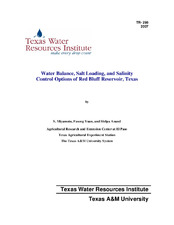| dc.description.abstract | Red Bluff is the main reservoir of the Pecos River in Texas, and its maximum storage capacity adjusted to sediment accumulation is estimated at 357 million m3 (289,600 acre-ft.).
Aside from the shortage of water entering the reservoir, high salinity has been a concern. This
report was prepared with three main objectives: i) to outline water balance of the reservoir, ii) to
establish salt loading trends over the past several decades, and iii) to evaluate the impact of salt
loading on salinity of the reservoir and its outflow. We also outlined the needs for salinity
control, and briefly discussed salinity control options.
The data used in this report were gathered through an EPA project entitled “Basin-wide
Management of the Texas Pecos River”, and consisted of flow and salinity data from various
agencies. Flow data are fairly reliable as the discharge is measured daily at a number of stations.
Salinity data have been taken several times a month to several times a year, and may be
considered “sketchy” at best. However, an effort was made to establish salinity and flow
relationships, so that salinity measured under a certain flow condition can be extrapolated to the
monthly flow. Flow and salt loading analyses were performed since 1959, and the water balance
analyses from 1991 through 2001 during which a complete set of flow, storage, and salinity data
was available.
The analyses of flow balance indicate that the inflow into Red Bluff from 1991 through
2001 averaged 95 million m3 (77,000 acre-ft.) per year from the Pecos, and 31 million m3
(25,000 acre-ft.) from the Delaware River (DWR). These flow means are higher than the longterm
(1959-2001) averages of 84 and 21 million m3 from the Pecos and the DWR, respectively.
The reservoir storage during 1991-2001 fluctuated widely between 47 to 186 million m3 with a
mean of 100 million m3 (81,000 acre-ft). The recorded annual surface outflow averaged 59
million m3, the estimated evaporation losses, 35 million m3, and the estimated percolation loss,
41 million m3 per year or 33% of the total inflow. About 8.7 of the 41 million m3 appears to be
returning to the River above Orla. Ignoring the high percolation loss estimated in two out of
eleven years, the seepage losses appear to have averaged 37 million m3 (30,000 acre-ft) per year.
This estimate of percolation losses is subject to the reliability of reservoir outflow measurements.
Salinity of the Pecos River at Malaga (NM) averaged 4100 mg L-1 in arithmetic mean,
and 3320 mg L-1 in flow-weighted during 1959 to 2001. Since 1991, the flow-weighted mean at
this location averaged 3500 mg L-1. Salinity of the DWR was estimated at 2600 mg L-1, and the
flow-weighted salinity of the composite flow which enters Red Bluff was 4425 mg L-1 since
1991. Salinity of outflow from the reservoir since 1991 averaged 6150 mg L-1, thus registering
an annual mean salinity increase of 1700 mg L-1 in flow-weighted, and 650 mg L-1 in arithmetic
mean between the inflow and the outflow since 1991.
Salt loading into Red Bluff averaged 478,000 tons per year since 1991, and is stable. The
best loading estimate from the Pecos and the DWR combined is 560,000 tons per year or
somewhat higher. Salt loading from Malaga Bend is estimated at 150,000 tons per year since
1991, as compared to the long-term mean of 172,000 tons/year. Salt load of the reservoir
outflow since 1991 is estimated at 410,000 tons/year which includes seepage returning back to
the river.
Salinity of the reservoir release (6150 mg L-1 on the average) is too high for irrigated
production of most crops, except for highly salt tolerant types, such as cotton and hay. It is not
acceptable for poultry, and is marginal for livestock. It also limits biodiversity of both aquatic
and riparian species. Salt loading from the Pecos measured at Langtry, (where the Pecos enters
the Rio Grande) has averaged 429,000 tons per year since 1986. This accounts for 26% of salt
loading (or 30% of gauged inflow) into Amistad, while providing only 9% of the total inflow
into the reservoir. This is not an ideal situation as salinity of the Amistad International Reservoir
located downstream is nearing 1000 mg L-1, the upper limit of drinking water standard in Texas.
The proposed control of brine intrusion at Malaga Bend seems to be the most effective
option for lowering salinity of the Pecos River entering Red Bluff. When this source is
controlled, salinity of the reservoir outflow can be reduced to the salinity level reported during
1937 to 1940, which is 4710 mg L-1. Salinity can be lowered even more if saline water intrusion
near Chain Lakes (east of Roswell, NM) is controlled. Saline water intrusion controls not only
reduce salinity, but can also reduce salt load of the Pecos River entering the Rio Grande, then
Amistad Reservoir. The reduction of seepage losses at reservoirs upstream should also help
reduce salinity of the Pecos River downstream. | en |


